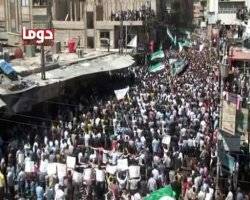The first international observers tasked with monitoring a tenuous United Nations-backed ceasefire have arrived in Syria, where activists said government forces were continuing to attack opposition neighborhoods.
"They've arrived and they will start work tomorrow morning," said Kieran Dwyer, a spokesman for the UN peacekeeping department, announcing that six unarmed military observers arrived in Damascus late on Sunday evening.
The six observers were part of an initial batch of 30 UN monitors due to enforce the ceasefire. The UN says the final observer mission will involve about 250 monitors.
Ahmed Fawzi, a spokesman for Annan, said the UN Security Council would be asked to approve deployment of the full mission, assuming the ceasefire held, based on a report by UN chief Ban next week.
"The mission will include civilians, political officers and human rights experts in order to observe the full implementation of the six-point plan, which includes a lot more than the cessation of hostilities," he said.
Earlier in the day, forces loyal to President Bashar al-Assad's government shelled areas of the city of Homs that were mostly occupied by opposition fighters and activists.
Government forces also engaged in clashes with opposition gunmen.
Activists said that at least five civilians had been killed in Sunday's violence.
Ban Ki-moon, the secretary-general of the United Nations, said that he was "very much concerned" at the renewed killings, and he urged the government to ensure that the ceasefire did not collapse.
The Syrian government said that it would not be responsible for the safety of the monitors, however, unless it was involved in "all steps on the ground", Bouthaina Shaaban, a spokesperson and presidential adviser, said.
She said Syria reserved the right to agree on the nationality of those participating in the mission.
Walid Muallem, the country's foreign minister, meanwhile, was due to discuss the six-point peace plan outlined by joint United Nations-Arab League envoy Kofi Annan with Yang Jiechi, his Chinese counterpart, SANA reported.
'What ceasefire?'
Government forces on Sunday subjected the al-Khalidiya and Bayada neighborhoods of Homs to fierce bombardment, despite the fact that both the government and opposition had agreed to a ceasefire that came into effect at dawn on Thursday.
Three civilians were killed in Homs city, including one in al-Khalidiya, the Syrian Observatory for Human Rights (SOHR) said.
Rami Abdel Rehman, the head of the UK-based rights group, said that a fourth was shot dead in central Hama province and the fifth died in the Damascsus suburb of Douma.
Activists told Al Jazeera that Syrian security forces had also shelled the village of Kherbet al-Jouz, in Idlib province, where there is a heavy presence of the Free Syrian Army, a group of armed opposition fighters and defectors from the Syrian army.
Al Jazeera is unable to independently verify reports of violence, as the Syrian government has placed strict restrictions on reporting.
Ahmed Ben Helli, the deputy chief of the Arab League, said that Annan was due to report on his mission and the ceasefire to the League during a meeting in Qatar on Tuesday.
In Homs, however, activists said the ceasefire was a smokescreen.
"What ceasefire? There's an explosion every five to six minutes," said Yazan, a Homs-based activist, contacted via Skype by the Associated Press news agency.
"I can also hear the sound of a reconnaissance plane. It's flying very low.''
In an amateur video posted on the internet by activists on Sunday, explosions and gunfire could be heard echoing as al-Khalidiya's skyline is engulfed in grey smoke.
"If you saw Homs right now you wouldn't recognise it,'' said Yazan, describing rubble-strewn roads and badly damaged apartment blocs.
"You walk around and it's not unusual to find dead people in cars on the street," he said, giving only his first name for fear of retribution.
The Local Co-ordination Committees activist network said the day started with a barrage of shells that fell at the rate of six each minute, shaking al-Khalidiya for the second consecutive day.
Trading blame
Both sides have blamed each other for violations of the ceasefire, and on Sunday the government insisted that the country's sovereignty must be respected.
"Syria endorsed the UN observer mission because it has nothing to hide and hopes that these observers will convey the real picture of what is happening on the ground," the official news agency said.
SANA reiterated the government's repeated accusations that "armed fighters groups funded and armed by foreign parties" are responsible for the violence in Syria.
Syria accepted observers because its "main request was the monitoring of the opposition fighters ' crimes" and because it was part Annan's six-point plan which Damascus accepted, SANA said.
According to the SOHR's figures, 32 people have been killed since the ceasefire came into effect, a number that is sharply down from the figures documenting violence before Thursday.
On Sunday, the authorities charged that the opposition was "intensifying" attacks on security forces and civilians.
The United Nations estimates that more than 9,000 people have been killed in violence related to the uprising against Bashar al-Assad's government since protests began in March 2011.
PHOTO CAPTION
This image made from amateur video and released by Douma Revolution in Syria Friday, April 13, 2012 purports to show a large anti-government demonstration in Douma, Syria.
Aljazeera


 Home
Home Discover Islam
Discover Islam Quran Recitations
Quran Recitations Lectures
Lectures
 Fatwa
Fatwa Articles
Articles Fiqh
Fiqh E-Books
E-Books Boys & Girls
Boys & Girls  Hajj Rulings
Hajj Rulings Hajj Fatwas
Hajj Fatwas














